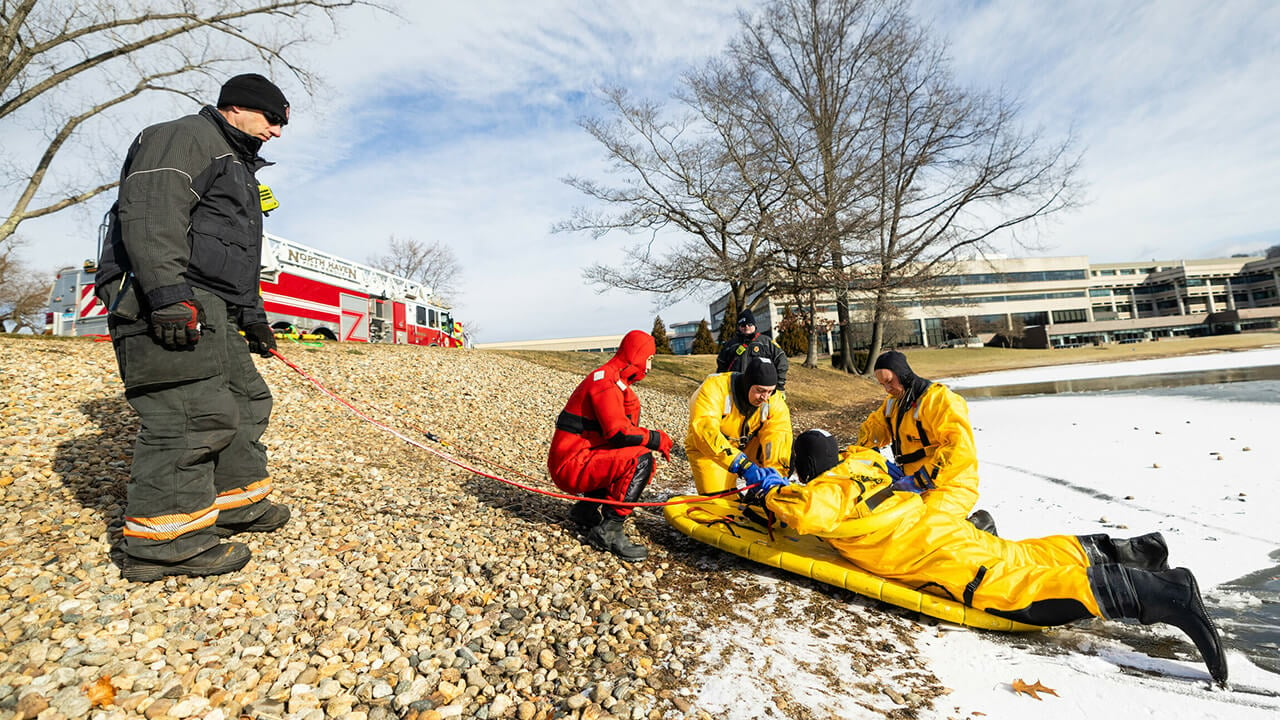The picturesque ponds of Quinnipiac’s North Haven Campus became a frozen classroom last week as 55 members of the North Haven Fire Department took the plunge and participated in several days of ice rescue simulation drills.
Made possible through the ongoing collaboration between the fire department and Quinnipiac, the training symbolizes something deeper — a partnership built on shared resources and a mission to ensure a safer community.
“Quinnipiac has been a tremendous partner,” said Scott Bisson, deputy fire chief of operations. “And we’re proud to reciprocate that support and lend our own resources to the university, whether it’s to help conduct training classes for the Quinnipiac Emergency Medical Services team or the university’s EMT paramedics. It’s an active partnership that also strengthens our community.”
With warmer winters trending over the past several years, Bisson said the frozen pond on the North Haven Campus provided a valuable opportunity to test ice rescue equipment and conduct life-saving drills. During the week, air temperatures ranged from 30 to 35 degrees, while the sub-freezing water was estimated below 33 degrees. One of the five sessions featured a Wednesday night drill, designed to enhance training by addressing low-visibility scenarios. Each session included 10 personnel members with the newest team members taking the icy plunge to be “rescued.”
“I'm picking the most junior people with the least amount of experience in the cold-water rescue suits to go into the water,” said Bisson. “It’s training on what we call perishable skills. We want our muscle memory to be really sharp when we're out there on the ice, and we want everybody to be very comfortable with the equipment and procedure, because in the field when you’re under stress, those skills need to be second nature.”
Drills began with a review of the equipment and PPE to reinforce proper handling procedures and to verify that everything was in working condition. Each team member is assigned a role, ranging from coordinating a command structure on-site to preparing to haul personnel back to shore. As their fellow firefighter takes sliding, careful steps onto the ice, the mood is tense as everyone listens for snaps and watches closely for cracks with each step. After immersing themselves into the freezing water, the “victim” is rescued and transported safely back to shore for a debrief on the drill.
In all water rescue missions, Bisson says that one of the most critical elements is time.
“Time is of the essence. If you are ever in a water emergency, call 911 immediately before attempting a rescue on your own. Grab a branch to help pull someone in but be cautious about going out on the ice. You could fall through as well,” said Bisson. “And make sure you know the location of the person when they fell in. Find some kind of landmark or use the ‘what3 words’ app to note the location. But always call 911 immediately. Help is on the way.”































